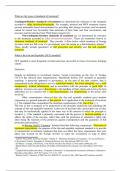Summary
Summary LLM International Dispute Resolution - Investment Treaty Arbitration II - Module 5 (Arbitrator’s Independence & Impartiality)
- Course
- Institution
• Definition • Standards • National laws • Institutional rules • IBA Guidelines o Part 1 o Part 2 • Conflicts of interest • Procedure o Commencement of arbitration o During arbitration o After award/Annulment of award • Consequences o Before appointment o After appoint...
[Show more]



